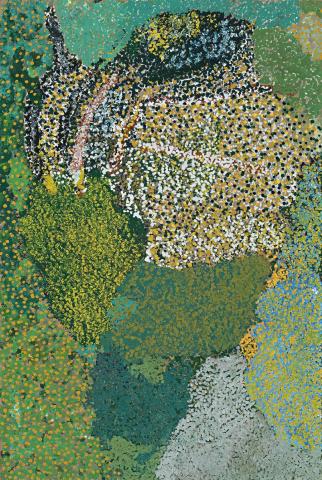ARTIST'S COUNTRY, 1992
Milliga Napaltjarri
synthetic polymer paint on linen
91.0 x 61.5 cm
inscribed verso: artist's name, size, Warlayirti Artists cat. 151/92
Warlayirti Artists, Balgo Hills
Gallery Gabrielle Pizzi, Melbourne
Private collection, New York
Sotheby's, Melbourne, 25 July 2005, lot 91
Niagara Galleries, Melbourne (label attached verso)
Private collection, Melbourne
Ryan, J., Images of Power: Aboriginal Art of the Kimberley, National Gallery of Victoria, Melbourne, 1993, p. 99
Sotheby's Aboriginal Art, 26 July 2004, p. 53, pl. 67 for two closely related examples executed in the same year using a similar palette
Differing in iconography and palette to the Western Desert paintings of male artists, the women of Balgo Hills produce work whose thematic concerns are underpinned by the same engagement with custodial ownership. With associated songs, dances, mythology and designs, women's responsibilities within the social structure manifest in paintings through the presence of food–gathering symbols overlayed with brilliant stippling and textural fields of colour. Less concerned with the mapping of ancestral tracking and sites, the paintings produced by senior artists such as Milliga Napaltjarri reflect an engagement with colour and tone whilst also containing deeply coded under–layers of symbolic meaning.
As noted by Senior Curator Judith Ryan, ‘Milliga Napaltjarri, a senior artist, uses an informal, layered technique to advantage... Body design for women's rituals are painted first as an under layer, which is then concealed by tight clusters if textural dots, applied in a loose, uneven manner, free of crafted artifice. The underlying designs are dark. The lightest tones are painted last with a spontaneity akin to finger painting. The irregular massings of colour burst out of the darker ground to invoke fruiting of plants and seeding of grasses. The composition is informal and open and relies on variegated patches of vibrant particles.'1
1. Ryan, J., Images of Power, Aboriginal Art of the Kimberley, National Gallery of Victoria, Melbourne, p. 92
